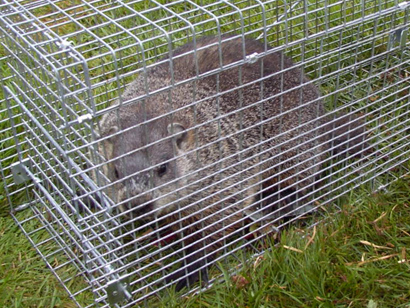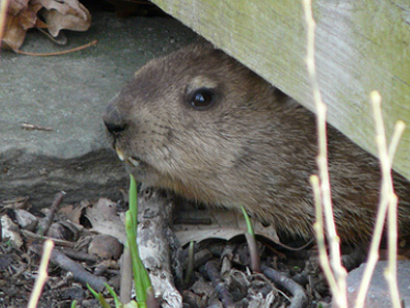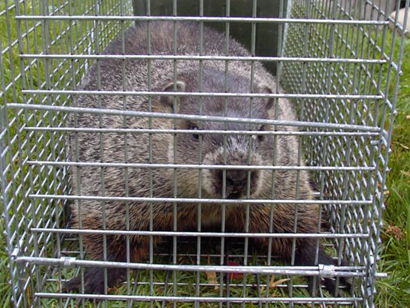- Groundhog Removal - Information about the humane trapping and removal of groundhogs.
Groundhog Removal
COMMON PROBLEMS: Groundhogs are common in suburban areas throughout most of the northeast United States. They build an underground labyrinth of tunnels. They often dig next to or under human structures, which can undermine foundations. They will sometimes dig and live under porches, decks, sheds, etc. They are also herbivores, and are known for raiding gardens and eating crops. They are otherwise cautious and shy, and they are never aggressive, and they don't really carry or transmit any important diseases. That's about it. In summary groundhogs cause some of the following problems:
- Digging a large burrow, or several, next to a building.
- Living under a shed, deck, or porch, and digging there.
- Eating a garden, or ornamental plants, crops, etc.
- Holes in the yard are dangerous to horses or other animals.
GROUNDHOG UNDER A SHED OR PORCH: Here are the general steps for removing groundhogs from under a deck, porch, or shed..
- Step 1: Inspect the structure, and find the entry hole(s), which are usually obvious - often of course, the whole structure is open around the perimeter.
- Step 2: Rather than simply set traps, the best option is to install an exclusion barrier, such as steel screen, around the entire perimeter, while leaving just one opening open.
- Step 3: Install a one-way exclusion door on the opening, or the proper sized cage traps.
- Step 4: Be sure any baby groundhogs are able to exit. If not, if they are too small, they must be removed by hand.
- Step 5: Relocate the animals at least 10 miles from capture site.
- Step 6: Once all the groundhogs are out, seal the last open area shut.
GENERAL GROUNDHOG TRAPPING: Groundhog trapping is subject to state laws regarding capture and relocation or euthanization of wildlife. If you have unwanted groundhogs outside the home, in some cases, the only fix is to trap and remove the nuisance wildlife. We can safely, legally, and effectively catch and remove your nuisance groundhogs. Trapping is an art, and most amateur attempts go awry for a variety of reasons. An intimate knowledge of groundhog behavior, and of various groundhog trap types is necessary to ensure that the groundhog is trapped and removed without incident.
- STEP 1: Determine if trapping is necessary, or if there is a preventative alternative.
- STEP 2: Select the right trap for the situation.
- STEP 3: Set the traps in the correct areas, in the shade, camouflaged, on a flat sturdy surface, away from any obstructions or areas that can be damaged, etc.
- STEP 4: Use the correct bait. Usually fresh vegetables are best.
- STEP 5: Monitor the trap daily, remove trapped groundhogs and transport them.
Also visit my How To Get Rid Of Groundhogs yourself page for more information about groundhog removal methods. I also have information about Groundhog Trapping methods on this page, and general Groundhog Prevention to keep them off of your property.
I often get asked How to Kill a Groundhog - and this page helps you decide whether or not it is a good option for your situation. I also have information about Groundhog Repellents, as well as if mothballs or ammonia help repel groundhogs if that is more appealing. We also have information on whether or not a high pitch sound deterrent machine will work against groundhogs.
Often trapping a groundhog is the better option - find out here What equipment is needed to trap a groundhog?, as well as what bait catches groundhogs.
Groundhog Information
Biology
When dealing with an unwelcome guest on your property, it's important to first Know your Groundhogs. Groundhogs, also known as Woodchucks in some regions, are basically rodents and belong to the family of large ground squirrels. They are one of the largest in the family of squirrels and measure from 40 cm to 65 cm in length. This includes about 15 cm of tail. Researchers have also come across a few groundhogs that grew to around 80 cm in length. Find out more about How big do groundhogs get. They weigh around two to four kilograms, really like to dig holes, and are well adapted to do so. They have short and powerful limbs along with thick sharp claws, a curved spine and the body is covered with a thick layer of fur. This helps in keeping them warm. In the wild, they live for around two to three years but can go up to six years as well. In captivity, they are known to have lived for nine to 14 years. They are hunted down by wolves, foxes, coyotes, bobcats, hawks, dogs and bears. Groundhogs are primarily herbivorous in nature and like consuming wild grass and vegetables. A few times they have also been spotted preying on small insects, grasshoppers and snails. An interesting thing to note is that they do not consume water but are hydrated by the consumption of leafy plants. They are good swimmers and tree climbers and use the arts to escape the predators.
Habitat
Groundhogs use burrows for sleeping, hibernating and rearing young ones. They take out approximately 320 kg of mud while digging a burrow. Usually more than one groundhog resides in a burrow which has two to five entry or exit points. This provides them with options to get away in case a predator attacks. The tunnels are really large and length of one can be around 14 meters and can be as deep as around 1.5 meters. Their digging not only harms the crops but poses a great danger to buildings as well.
Life Cycle
Groundhogs usually breed from early March to late April after they come out of hibernation. Most of them breed during the second year of their life while a very small percentage does so during the first year as well. The male and female stays together for around 30 days and just before the birth of a young one, the male leaves the den. The female groundhog gives birth to two to six babies at a time. They are blind and hairless at the time of birth and a great care is required from the part of mother groundhog till the time they are strong enough to move out. They usually stay there for five to six weeks before going out and making their own dens. The groundhogs also make a separate burrow for hibernating in the winter time. This is really well-made and keeps the temperature well above the freezing point. They gain a lot of weight before entering hibernation and use the stored mass during the winter.
Diseases they carry
Groundhogs are known to be carriers of diseases like rabies and hepatitis which can be transferred to humans in case of a bite. Care must be taken while dealing with them and taking the help of an expert is advisable. However, they are widely used in medical research including Hepatitis B and Liver Cancer.
Nuisance Concerns
Groundhogs are known to cause a lot of trouble to humans. Since they stay in burrows and feed on vegetation they cause extensive damage to crops. They destroy almost all kinds of plants they can find. Also, the burrows created by them causes a lot of damage to other animals like a broken leg if one steps in it accidently. The deep burrows they make also damages the foundation of a building. While burrowing, they remove the mud which damages the foundation and thus can lead to damaging the entire setup. Do you Got a Groundhog? Find out here How to Evict a Groundhog, as well as whether or not repellents will get a groundhog out of your property. There are lots of good reasons to keep groundhogs away from your property, and we can help you find out how.




